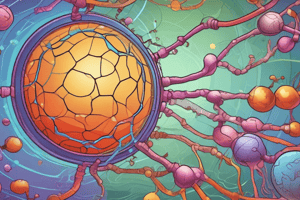Podcast
Questions and Answers
What is the primary role of the diaphragm in respiration?
What is the primary role of the diaphragm in respiration?
- Changing shape to aid in inhalation and exhalation (correct)
- Facilitating gaseous exchange through alveoli
- Maintaining lung pressure during breathing
- Separating the thoracic cavity from the skull
What happens to the rib cage during expiration?
What happens to the rib cage during expiration?
- It expands outward and upward
- It temporarily detaches from the spine
- It remains static throughout the process
- It contracts inward and downward (correct)
Which aspect does not belong to the mechanisms of respiration?
Which aspect does not belong to the mechanisms of respiration?
- External metabolism (correct)
- Breathing
- Cellular respiration
- Internal respiration
What occurs to the pressure in the lungs during inhalation?
What occurs to the pressure in the lungs during inhalation?
Which process directly contributes to the formation of ATP?
Which process directly contributes to the formation of ATP?
Which respiratory surface is used by amphibian tadpoles?
Which respiratory surface is used by amphibian tadpoles?
What primary function does the larynx serve in the respiratory system?
What primary function does the larynx serve in the respiratory system?
What is the role of the epiglottis during swallowing?
What is the role of the epiglottis during swallowing?
Which part of the respiratory system is responsible for moistening and warming the inhaled air?
Which part of the respiratory system is responsible for moistening and warming the inhaled air?
What type of epithelial tissue lines the trachea?
What type of epithelial tissue lines the trachea?
Which organism primarily utilizes book lungs for respiration?
Which organism primarily utilizes book lungs for respiration?
The nasal cavity is divided into right and left chambers by which structure?
The nasal cavity is divided into right and left chambers by which structure?
Respiratory gas exchange occurs in the lungs and is facilitated by which system in the body?
Respiratory gas exchange occurs in the lungs and is facilitated by which system in the body?
Which animals primarily breathe using internal gills?
Which animals primarily breathe using internal gills?
Why is respiration without a circulatory system challenging for large animals?
Why is respiration without a circulatory system challenging for large animals?
What part of the pharynx connects to the nasal cavity?
What part of the pharynx connects to the nasal cavity?
What is the primary function of the larynx?
What is the primary function of the larynx?
Which statement about the trachea is correct?
Which statement about the trachea is correct?
What structure does the trachea branch into?
What structure does the trachea branch into?
How are the lungs protected?
How are the lungs protected?
What do bronchioles end in?
What do bronchioles end in?
Which of the following statements about alveoli is true?
Which of the following statements about alveoli is true?
What is a characteristic feature of the bronchi?
What is a characteristic feature of the bronchi?
What is respiration primarily responsible for in living organisms?
What is respiration primarily responsible for in living organisms?
Which of the following is NOT a characteristic of an efficient respiratory surface?
Which of the following is NOT a characteristic of an efficient respiratory surface?
What is the chemical equation representing the process of cellular respiration?
What is the chemical equation representing the process of cellular respiration?
How do gases primarily exchange in plants?
How do gases primarily exchange in plants?
Why is it crucial for respiration to not occur in a single step?
Why is it crucial for respiration to not occur in a single step?
What are lenticels in woody flowering plants responsible for?
What are lenticels in woody flowering plants responsible for?
What feature of animal respiratory organs varies widely among different species?
What feature of animal respiratory organs varies widely among different species?
During aerobic respiration, what is the primary waste product released?
During aerobic respiration, what is the primary waste product released?
What happens during the process of inspiration?
What happens during the process of inspiration?
What is the primary function of the respiratory membrane?
What is the primary function of the respiratory membrane?
What constitutes the majority of oxygen transport in the blood?
What constitutes the majority of oxygen transport in the blood?
What is the normal volume of Tidal Volume (TV) during breathing?
What is the normal volume of Tidal Volume (TV) during breathing?
Which volume refers to the air that remains in the lungs after maximum exhalation?
Which volume refers to the air that remains in the lungs after maximum exhalation?
What is the approximate range for Total Lung Capacity after maximum forced inspiration?
What is the approximate range for Total Lung Capacity after maximum forced inspiration?
During expiration, what happens to the thoracic volume?
During expiration, what happens to the thoracic volume?
What volume of air is considered Dead Space (DS) in the respiratory tract?
What volume of air is considered Dead Space (DS) in the respiratory tract?
What role do external intercostal muscles play during inspiration?
What role do external intercostal muscles play during inspiration?
What substance is formed when CO₂ is absorbed by red blood cells in the tissue?
What substance is formed when CO₂ is absorbed by red blood cells in the tissue?
What is the primary role of Carbonic Anhydrase in the red blood cells?
What is the primary role of Carbonic Anhydrase in the red blood cells?
Which ions move into the red blood cell during the chloride shift?
Which ions move into the red blood cell during the chloride shift?
What happens to bicarbonate ions when red blood cells reach the lungs?
What happens to bicarbonate ions when red blood cells reach the lungs?
What is the process called when CO₂ diffuses out of red blood cells into the lungs?
What is the process called when CO₂ diffuses out of red blood cells into the lungs?
What is the primary function of haemoglobin in the body?
What is the primary function of haemoglobin in the body?
What determines the degree of saturation of haemoglobin with oxygen?
What determines the degree of saturation of haemoglobin with oxygen?
How many molecules of oxygen can one molecule of haemoglobin theoretically bind?
How many molecules of oxygen can one molecule of haemoglobin theoretically bind?
What effect does an increase in carbon dioxide concentration have on the oxygen-haemoglobin dissociation curve?
What effect does an increase in carbon dioxide concentration have on the oxygen-haemoglobin dissociation curve?
What percentage of carbon dioxide is transported as bicarbonate in the body?
What percentage of carbon dioxide is transported as bicarbonate in the body?
What is a primary symptom of emphysema?
What is a primary symptom of emphysema?
What is a common cause of emphysema?
What is a common cause of emphysema?
Which mechanism describes the release of oxygen from haemoglobin in tissues with high ppCO2?
Which mechanism describes the release of oxygen from haemoglobin in tissues with high ppCO2?
Which of the following treatment options is typically recommended for someone with emphysema?
Which of the following treatment options is typically recommended for someone with emphysema?
What is formed when carbon dioxide reacts with haemoglobin in red blood cells?
What is formed when carbon dioxide reacts with haemoglobin in red blood cells?
What physiological change occurs in the alveoli due to emphysema?
What physiological change occurs in the alveoli due to emphysema?
What happens to the saturation of haemoglobin at a ppO2 of 30 mmHg?
What happens to the saturation of haemoglobin at a ppO2 of 30 mmHg?
Which of the following is NOT a symptom associated with emphysema?
Which of the following is NOT a symptom associated with emphysema?
What is the primary function of the Hering-Breuer reflex?
What is the primary function of the Hering-Breuer reflex?
What role does the respiratory centre play in breathing regulation?
What role does the respiratory centre play in breathing regulation?
Which symptom is associated with emphysema?
Which symptom is associated with emphysema?
What triggers the inhibitory impulses to the inspiratory center during breathing?
What triggers the inhibitory impulses to the inspiratory center during breathing?
Which factor limits the frequency of breathing in humans?
Which factor limits the frequency of breathing in humans?
Which respiratory disorder is primarily characterized by inflammation and mucus production?
Which respiratory disorder is primarily characterized by inflammation and mucus production?
What happens when air leaves the lungs during expiration?
What happens when air leaves the lungs during expiration?
Which of the following best describes the role of hemoglobin in oxygen transport?
Which of the following best describes the role of hemoglobin in oxygen transport?
Flashcards are hidden until you start studying
Study Notes
Respiration Overview
- Respiration is a biochemical process that oxidizes organic compounds, releasing chemical energy as ATP.
- Gaseous exchange is critical and occurs at the respiratory surface.
Importance of Respiration
- All organisms need energy for life processes; ATP provides usable energy from potential energy stored in organic compounds.
- Continuous respiration is essential for energy conversion.
Respiratory Surface Features
- Must have a large surface area for efficient gas exchange.
- Should be thin, vascular, and permeable.
- Needs to be moist to facilitate gas diffusion.
Gaseous Exchange in Plants
- Air spaces between plant cells enhance diffusion.
- Stomata on leaves allow oxygen to enter and carbon dioxide and water vapor to exit.
- Lenticels in woody plants serve as pores for gas exchange.
Animal Respiratory Systems
- Diverse types exist among animal groups, including specialized respiratory organs.
- Respiration often correlates with a transport system in higher organisms.
Human Respiratory System Composition
- Divided into upper and lower respiratory systems.
- Upper includes the nose, nasal cavity, and pharynx.
- Lower includes the larynx, trachea, bronchi, and lungs.
Anatomy of the Nose
- Contains external nares for air entry, divided into left and right nasal chambers.
- Vestibule filters air, respiratory part warms, and olfactory chamber detects smell.
Pharynx Structure
- Connects mouth and nose to the trachea, divided into nasopharynx, oropharynx, and laryngopharynx.
Larynx and Sound Production
- Known as the voice box; features vocal cords that vibrate to produce sound.
- Contains epiglottis to prevent food from entering the trachea during swallowing.
Trachea Characteristics
- Supported by C-shaped cartilage rings and lined with ciliated epithelium.
- Acts as a passage for air between the larynx and bronchi.
Bronchi and Lungs Structure
- The trachea bifurcates into right and left bronchi leading to each lung.
- Each lung is enclosed by a pleural membrane with a pleural cavity filled with fluid.
Alveoli Functionality
- Tiny air sacs where gas exchange occurs, surrounded by capillaries.
- Critical for oxygen uptake and carbon dioxide release.
Breathing Process
- Involves diaphragm and muscular contractions to change thoracic pressure.
- Inspiration occurs when the diaphragm contracts and lung volume increases.
Gas Exchange Mechanisms
- External respiration refers to gas exchange in the alveoli; internal respiration occurs at tissue levels.
- Oxygen and carbon dioxide transfer driven by partial pressures.
Oxygen Transport Mechanism
- Hemoglobin plays a crucial role, binding oxygen in the lungs and releasing it in tissues.
- Oxygen binding affinity changes with varying carbon dioxide concentrations (Bohr effect).
Carbon Dioxide Transport
- CO2 transported in plasma (7%), as carbaminohemoglobin (23%), and bicarbonate ions (70%).
- Exchanges facilitated by chloride shift in red blood cells.
Regulation of Breathing
- Governed by the nervous and chemical systems; respiratory centers in the brain control rate and depth.
- Hering-Breuer reflex helps maintain rhythm based on lung expansion and deflation.
Common Respiratory Disorders
- Emphysema, chronic bronchitis, laryngitis, and asthma noted for their specific symptoms and causes.
- Treatment typically targets symptom relief and underlying causes, such as lifestyle changes for smoking-related conditions.
Cellular Respiration
- Takes place within cells, transforming food into ATP through oxidation and phosphorylation.
- Crucial for fuelling cellular processes, maintaining life.
Studying That Suits You
Use AI to generate personalized quizzes and flashcards to suit your learning preferences.




